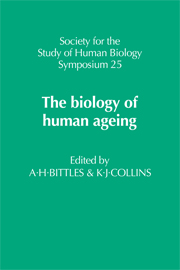Book contents
- Frontmatter
- Contents
- Preface
- Ageing as a consequence of natural selection
- Genetic information in ageing cells
- Insects as models for testing theories of ageing
- Human cell culture systems in the study of ageing
- Estimation of biological maturity in the older child
- Biological age assessment in adulthood
- Skeletal age and palaeodemography
- Cell death and the loss of structural units of organs
- The prospects for mortality decline and consequent changes in age structure of the population
- Where do old people come from? An evaluation of American population projections
- Age structure of Soviet population in the Caucasus: facts and myths
- The health of an ageing population
- Can we tell our age from our biochemistry?
- Dietary manipulation of ageing: an animal model
- Customary physical activity in the elderly
- Effects of ageing on human homeostasis
- Index
Cell death and the loss of structural units of organs
Published online by Cambridge University Press: 06 August 2010
- Frontmatter
- Contents
- Preface
- Ageing as a consequence of natural selection
- Genetic information in ageing cells
- Insects as models for testing theories of ageing
- Human cell culture systems in the study of ageing
- Estimation of biological maturity in the older child
- Biological age assessment in adulthood
- Skeletal age and palaeodemography
- Cell death and the loss of structural units of organs
- The prospects for mortality decline and consequent changes in age structure of the population
- Where do old people come from? An evaluation of American population projections
- Age structure of Soviet population in the Caucasus: facts and myths
- The health of an ageing population
- Can we tell our age from our biochemistry?
- Dietary manipulation of ageing: an animal model
- Customary physical activity in the elderly
- Effects of ageing on human homeostasis
- Index
Summary
The meaning of the term ‘ageing’ is open to much dispute when applied to biological studies (Chandler, 1952). Some workers use the term to cover all aspects of development, from fertilization to death, i.e. it stands simply for an increase in years; others restrict the ageing phase to the period when there is a rapid decrease in life expectancy. For the purposes of the present discussion ageing is defined as “a decrease in adaptation as a consequence of loss of tissue and functional reserves” (Albertini, 1952). This definition implies that a major feature of ageing is a decline in the ability of the homeostatic systems of the body to cope with fluctuations in the external world. An important qualification is that AlbertiniTs external world is the protective one that we have created through social evolution for ourselves and our valued livestock. In the ‘wild’, homeostatic failures would probably emerge before the equivalent of ‘threescore years and ten’ and be different from those of ‘old age’.
Specific tissue and functional reserves decline during early development by deletion and remodelling of organs through adaptive processes which aid survival. The purpose of this article is to raise the questions: Are any of the cellular changes in post-embryonic tissues adaptive in this embryonic sense? Further, do they become non-adaptive, according to Albertini's definition, only when the species is allowed to live on, protected from the forces of selection which controlled its evolution? In evolution, deletion of structures, either through failure to detect and repair errors or through the active dismantling of functional components would be adaptive if it were to be connected with an advantageous diversion of the resources elsewhere in the body.
- Type
- Chapter
- Information
- The Biology of Human Ageing , pp. 119 - 132Publisher: Cambridge University PressPrint publication year: 1986
- 1
- Cited by



